AppSheet launched in 2014 and was eventually acquired by Google in 2020. Today, the product is part of Google Workspace, and it allows you to build internal apps and visual interfaces for your existing databases. It’s often used for inventory management, order and delivery tracking, HR and project management tasks, and scheduling.
In contrast, Bubble’s no-code platform has been used to build and scale nearly 5 million applications over the last 10+ years, with startups and enterprises alike choosing to build on Bubble. Bubble’s visual programming platform gives you complete control and customization over design, data, and logic — all on one platform — and allows you to create apps of any type, for any audience.
Bubble and AppSheet offer very different benefits. While AppSheet is cheaper for some use cases, Bubble’s strengths lie in its:
- Versatility
- Customizability
- Performance
- Community
- Ecosystem
Of course, we are Bubble, and naturally we’re big fans of our own platform. That’s why we tapped the wider no-code community to find out what mattered most to them when choosing a platform. Then we used our findings to develop a rubric to more objectively compare Bubble to solutions like AppSheet.
In this article, we’ll show you how these two platforms stack up — and you’ll see why no matter what you’re trying to build, Bubble is a great option. If you want to learn more about the process of choosing the right tech for your use case, check out our Buyer’s Guide to No-Code Development Platforms.
AppSheet vs. Bubble: At-a-glance comparison
Let’s start with a high-level overview of how Bubble and AppSheet compare.
| AppSheet | Bubble | |
|---|---|---|
| Common use cases | AppSheet is a popular solution for creating internal tools and visual interfaces for Google Workspace databases. | Bubble is a full-stack, no-code platform that lets users create web and mobile apps of any kind, for internal or public use. |
| Where they shine | AppSheet is well-known for being a simple solution for templated, internal apps and automations. | Bubble offers complete customization, functionality, and control, without having to code. Even non-technical founders can easily build complex apps. |
| Overall score | ⭐⭐💫(2.89) | ⭐⭐⭐⭐ (4.00) |
| Use-case versatility | 🟨🟨🟨⬛⬛ | 🟩🟩🟩🟩🟩 |
| Full-stack coverage | 🟨🟨🟨⬛⬛ | 🟩🟩🟩🟩🟩 |
| Performance | 🟥🟥⬛⬛⬛ | 🟩🟩🟩🟩⬛ |
| Ecosystem | 🟥🟥⬛⬛⬛ | 🟩🟩🟩🟩⬛ |
| Cost | 🟩🟩🟩🟩⬛ | 🟨🟨🟨⬛⬛ |
| Customizability | 🟨🟨🟨⬛⬛ | 🟩🟩🟩🟩⬛ |
| Compliance | 🟩🟩🟩🟩🟩 | 🟩🟩🟩🟩⬛ |
| Code ownership | 🟥⬛⬛⬛⬛ | 🟨🟨🟨⬛⬛ |
| Learning curve | 🟨🟨🟨⬛⬛ | 🟨🟨🟨⬛⬛ |
| Resources | 🟩🟩🟩🟩⬛ | 🟩🟩🟩🟩⬛ |
| Community | 🟥🟥⬛⬛⬛ | 🟩🟩🟩🟩🟩 |
We wanted to compare these platforms based on what matters most to actual no-code developers. So, we asked them. In our 2024 State of No-Code Development Survey, more than 350 no-code founders, developers, freelancers, and hobbyists rated the importance of 17 factors when choosing a no-code builder.
In the fall of 2024, we scored Bubble and AppSheet from 1–5 in each of these areas, with 5 being the best score. Each score had specific requirements, and we’ll explain more about those below.
We also gave each platform an overall score using a weighted average. This was weighted based on how important a factor was to no-code developers in the survey. Here’s how Bubble and AppSheet compare.
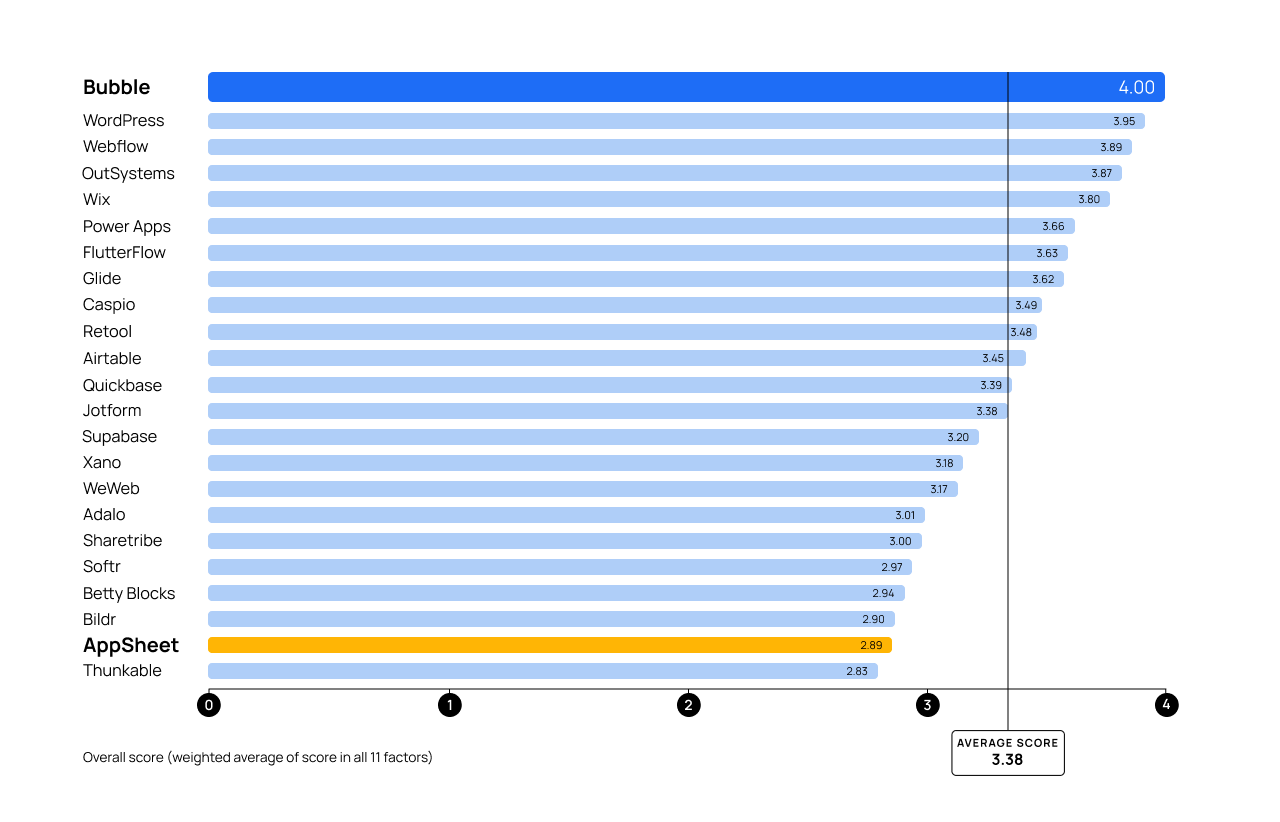
AppSheet vs. Bubble on use-case versatility
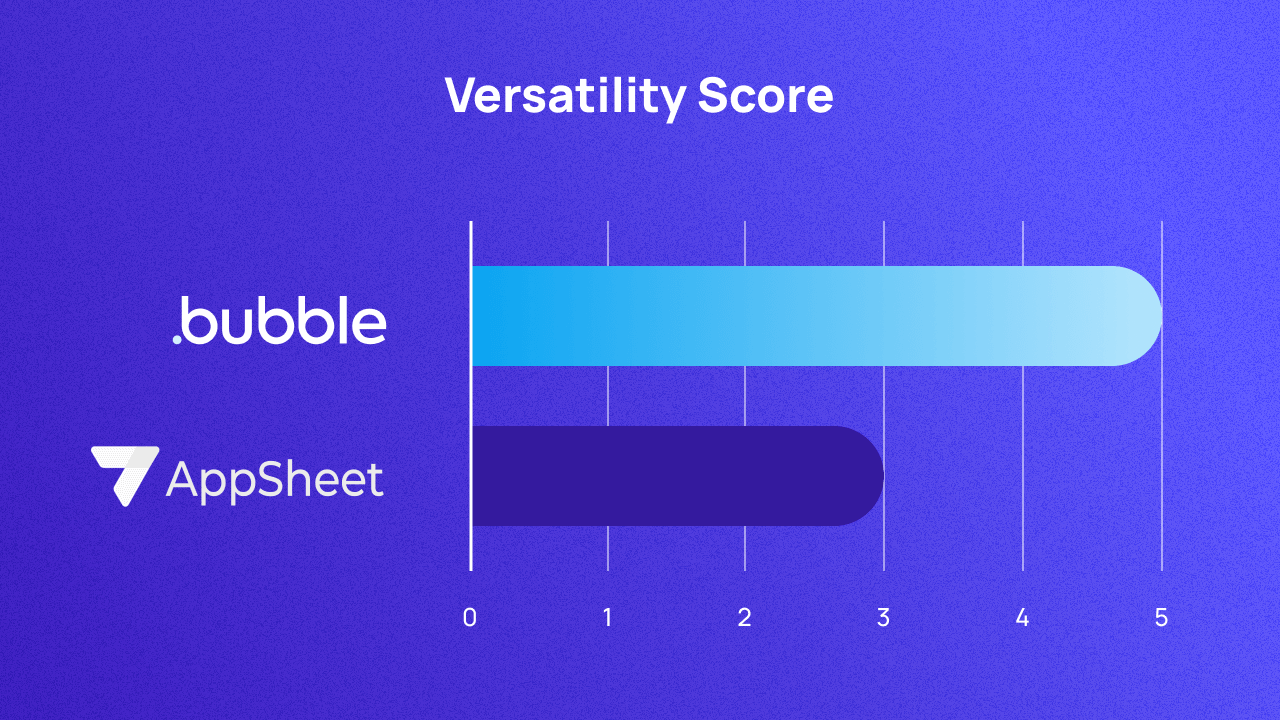
Use case versatility measures how flexible a product is: How many different types of apps or tools can you create with it? How many different use cases does it offer? Does it serve a broad audience or a specific one?
You don’t necessarily need a versatile tool, but versatility provides you with more flexibility and longevity. If a tool only serves one use case, and that’s what you need, then great! But if your needs change, or you decide to expand or pivot your app or tools over time, then you might be stuck starting from scratch somewhere else if you don’t begin on a platform that offers flexibility and versatility.
Our scores for use-case versatility rate each platform based on the range of use cases most people choose them for.
Bottom line: AppSheet provides versatility across industries, but is limited in the types of apps it can support. Bubble is a flexible and versatile solution that allows you to create any type of app for any industry.
| Score | Criteria |
|---|---|
| 1 | Not particularly well-known or well-perceived by the market for any use cases |
| 2 | Narrow set of use cases as perceived by the market |
| 3 | Use-case versatility across app types or industries, but not both. |
| 4 | Use-case versatility across either app types or industries, with some use-case versatility in the other category |
| 5 | Shown to be proficiently versatile across both app types and industries |
How AppSheet stacks up: AppSheet is sufficiently versatile across industries, but it’s fairly limited in terms of what kinds of apps it can help you create.
With AppSheet, you’re essentially creating frontends — a visual interface — for an existing database or spreadsheet. This can help you with simple app creation to make it easier for your team to manage and update that spreadsheet data. For example, teams might use AppSheet to create a tool for employees to log their time, or a sales team might use AppSheet to automate tasks and outreach.
AppSheet is also a common way to help manage inventory or collect data from field workers and manage dispatches. In short: AppSheet helps you create internal tools to manage your team’s work and data.
AppSheet's versatility score: 3/5
How Bubble compares: By contrast, Bubble is endlessly versatile — you can build any type of app you can imagine for any industry. With nearly 5 million apps created on Bubble, you’ll find all kinds of use cases, such as:
- MyAskAI, an AI-powered customer support SaaS tool
- A procurement portal for the City of Atlanta to make it easier to interact with their Oracle databases.
- A custom-built Human Resources Information System for Athena
- Strabo, a global personal finance tracking tool
- Flexiple, a job- and talent-searching marketplace
From internal tools to SaaS products, marketplaces to enterprise solutions, and more, Bubble gives you the flexibility to build different kinds of software in a wide range of industries. Use it as a frontend-only solution, a backend-only solution, or a full-stack solution. Keep your tools internal or scale them to millions of users. The choice is yours.
Bubble’s versatility score: 5/5
AppSheet vs. Bubble on full-stack coverage
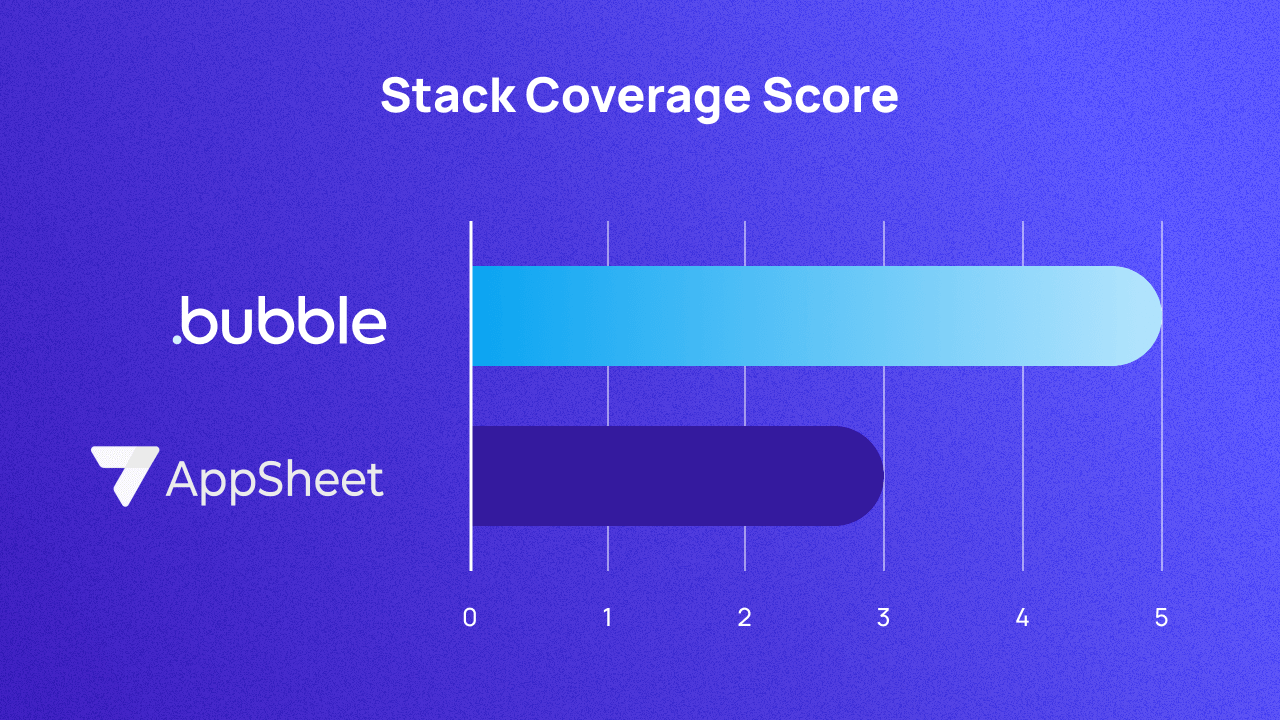
Your software “stack” refers to the design, data, and logic that powers your software. Many types of no-code builders focus on specific aspects of development. For example, they may focus solely on databases, or just on frontend design.
This means you may have to hard-code the other components or combine multiple platforms together for a full-stack solution, which can be both costly and cumbersome. We scored Bubble and AppSheet based on how many of these three components (design, data, logic) users can access — in other words, the degree to which the platform is a “full stack” solution.
Bottom line: AppSheet primarily covers design and logic, while Bubble offers a full-stack solution with built-in design, data, and logic all in one platform.
| Score | Criteria |
|---|---|
| 1 | Capabilities in one area: design, data, or logic |
| 2 | Capabilities in one area, gives user limited access to another |
| 3 | Capabilities in two areas |
| 4 | Capabilities in two areas, gives user limited access to the third |
| 5 | Full-stack: Capabilities in design, data, and logic |
How AppSheet stacks up: AppSheet primarily covers two components — design and logic. While it does have some native data capabilities, these have limited flexibility and many users seek an external data solution. Within AppSheet, you can control how your app looks and feels, based on pre-set templates and components within the platform.
You can also control the logic of your app — that is, how it works, what functionality it has, and how it uses the connected data. It also allows you to create “bots” based on “tasks” and “processes,” allowing you to set up automations and logic using an “If that, then this” format.
AppSheet's stack coverage score: 3/5
How Bubble compares: Bubble is one of the few full-stack no-code development platforms on the market. You never have to combine it with another solution to have complete control over the look and feel, data, and functionality of your app.
The benefits: faster performance, smoother development and editing, less “tech bloat,” fewer platforms to pay for, and a simple, all-in-one solution.
Bubble’s stack coverage score: 5/5
AppSheet vs. Bubble on performance
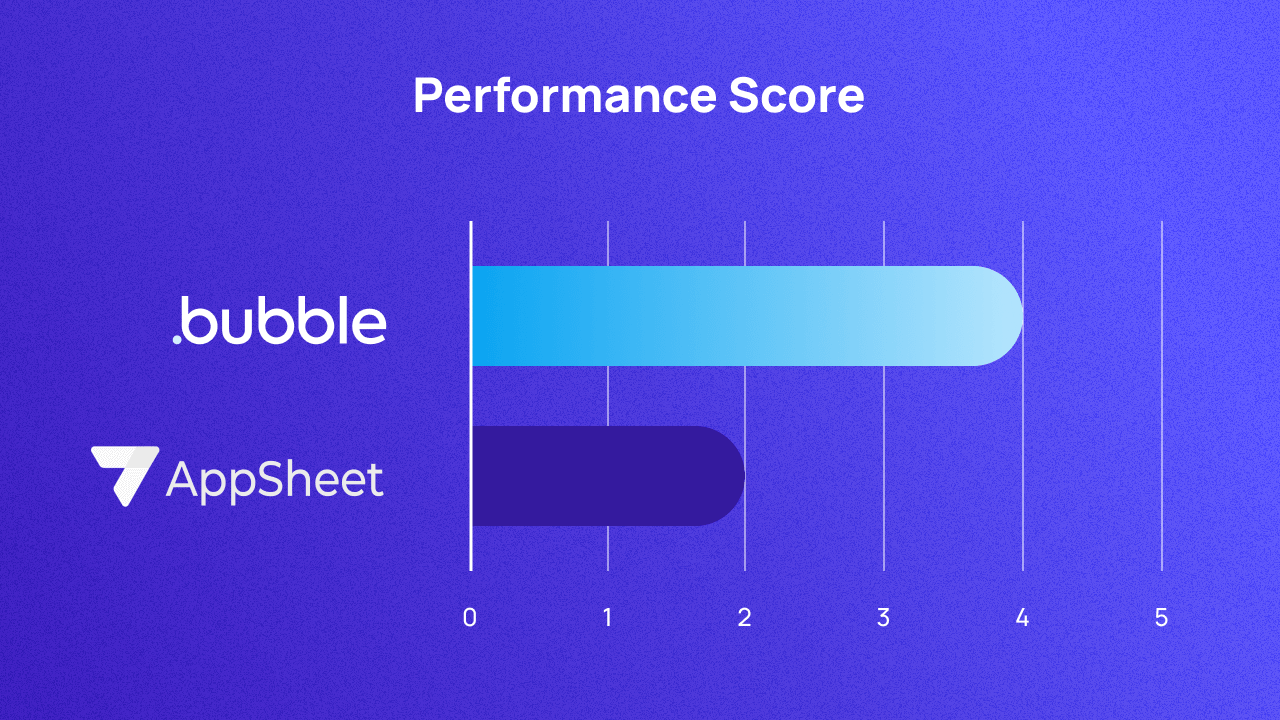
If the platform you’ve built on is unstable or slow, it can have a big impact on your app’s performance. When comparing Bubble and AppSheet, we considered how the platform performs as you scale up server demand — can it grow with you, or does performance take a hit when your user base grows too large?
Bottom line: Bubble provides much more transparency and stability compared to AppSheet when it comes to performance and outages.
| Score | Criteria |
|---|---|
| 1 | Frequent outages |
| 2 | Outages scale with user growth and/or company has no status page |
| 3 | Infrequent outages, but communicated with limited transparency to the user or sporadic outages, but quickly and transparently addressed |
| 4 | Infrequent outages, with any that do occur quickly and transparently addressed |
| 5 | Rare outages |
How AppSheet stacks up: Unfortunately, AppSheet doesn’t provide much transparency for users. You can see a resolved incidents page, but it doesn’t provide much information on the current or recent status of AppSheet.
In addition, AppSheet — at least historically — hasn’t done a great job at informing users about outages and resolutions, based on several forum posts asking about outages. And they have experienced a number of outages recently, according to several online status reports.
AppSheet's performance score: 2/5
How Bubble compares: At time of publication, Bubble had a 99.89% uptime over the last 90 days. As such, Bubble rarely experiences outages. But if they do happen, our team makes sure to both:
- Quickly detect and resolve the issue quickly to get you back online.
- Clearly communicate what’s happening and what we’re doing about it, so you’re never in the dark.
We know that our performance directly impacts the performance of your app and you and your user’s workflows, so we take pride in carefully managing our operations to bring you consistent, reliable performance. If you’re experiencing an issue, start by checking Bubble’s status page. You can also keep up to date on outages via @BubbleStatus on X and the forum.
Bubble’s performance score: 4/5
AppSheet vs. Bubble on ecosystem
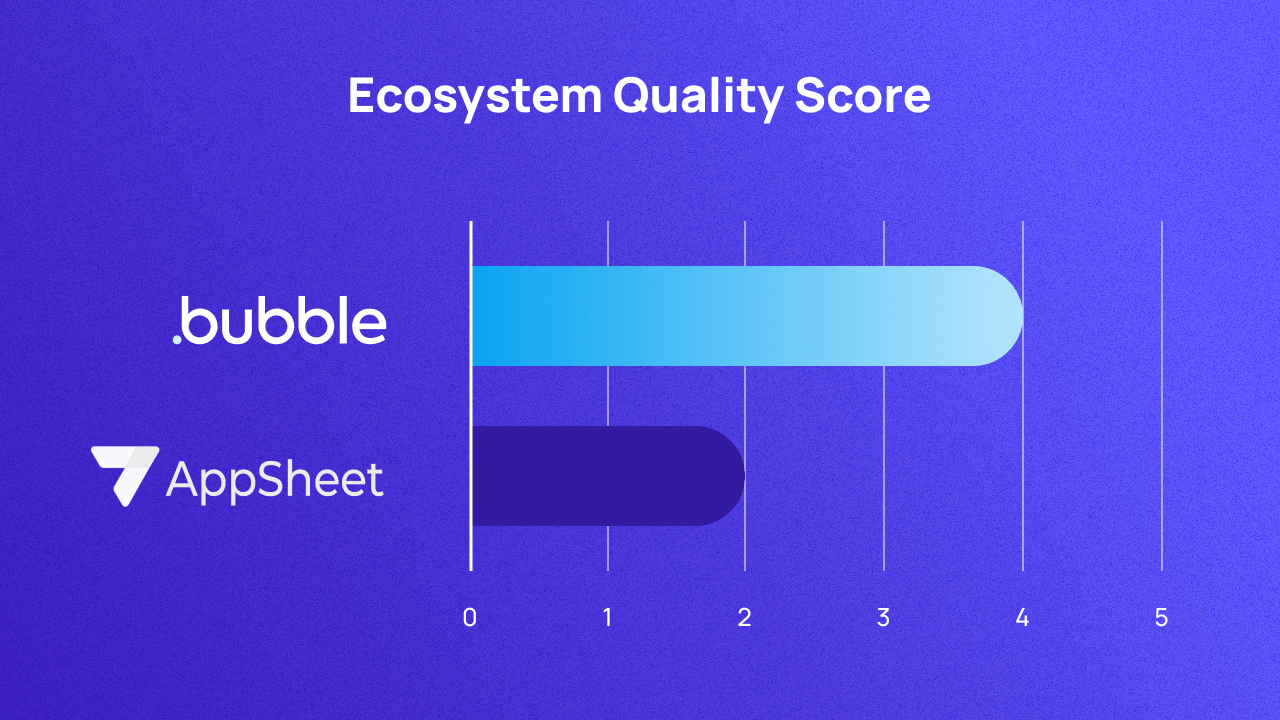
When it comes to picking a no-code tool, it’s not just about the platform itself. You also want to consider how that platform might integrate with other tools, especially other tools already in your (or your users’) tech stack.
Some no-code platforms offer robust ecosystems of seamlessly interconnected third-party tools, services, partnerships, and extensions, while others have more limited networks.
Our ecosystem quality scores are based on what third-party services a vendor offers, the third-party products that have been created, how accessible they are, and what partnerships they have.
Bottom line: AppSheet offers integrations with other Google tools, and basic app templates. By contrast, Bubble offers a robust ecosystem with plugins, integrations, templates, agency partnerships, and more to help you extend and power your app.
| Score | Criteria |
|---|---|
| 1 | Minimal third-party services that are challenging to use |
| 2 | Minimal third-party services, but they’re easier to use |
| 3 | Robust third-party services, but they’re challenging to use |
| 4 | Strong strategic partnerships; robust third-party services, but not perfectly seamless |
| 5 | Strong strategic partnerships; robust third-party services that are easy to use |
How AppSheet stacks up: When it comes to plugins and integrations, AppSheet doesn’t offer many. Mostly, AppSheet is a Google Suite product that connects seamlessly to other Google tools — think, Gmail, Google Maps, Sheets, Calendar, Drive, Docs, and Google Meet. You can access a few other integrations as well, or you can use a third-party service like Zapier to connect services.
AppSheet does offer basic app templates for their most common use cases (i.e., order and delivery tracking, inventory management, timesheets) and a partner directory if you want external support building your apps.
AppSheet's ecosystem score: 2/5
How Bubble compares: Unlike AppSheet, Bubble offers a robust ecosystem that gives you the freedom and flexibility to extend the powers of your Bubble software or connect Bubble apps with just about anything else in your tech stack.
With thousands of plugins and integrations available, you can connect your software with the other tools and services you need easily, without coding integrations yourself. (Although, if you want, you can even add your own plugins using APIs or coding them yourself.)
Plus, the Bubble community’s massive collection of templates helps you build the pages, layouts, workflows, and designs you want even faster. And Bubble has strategic partnerships with startup programs and universities including Microsoft For Startups, Harvard University, and Columbia University.Need to hire someone to build your app? Bubble’s agency database helps you filter and compare agencies that use Bubble by experience, services, cost, language, and region, so you can quickly find a partner that’s right for your project.
Bubble’s ecosystem score: 4/5
AppSheet vs. Bubble on cost
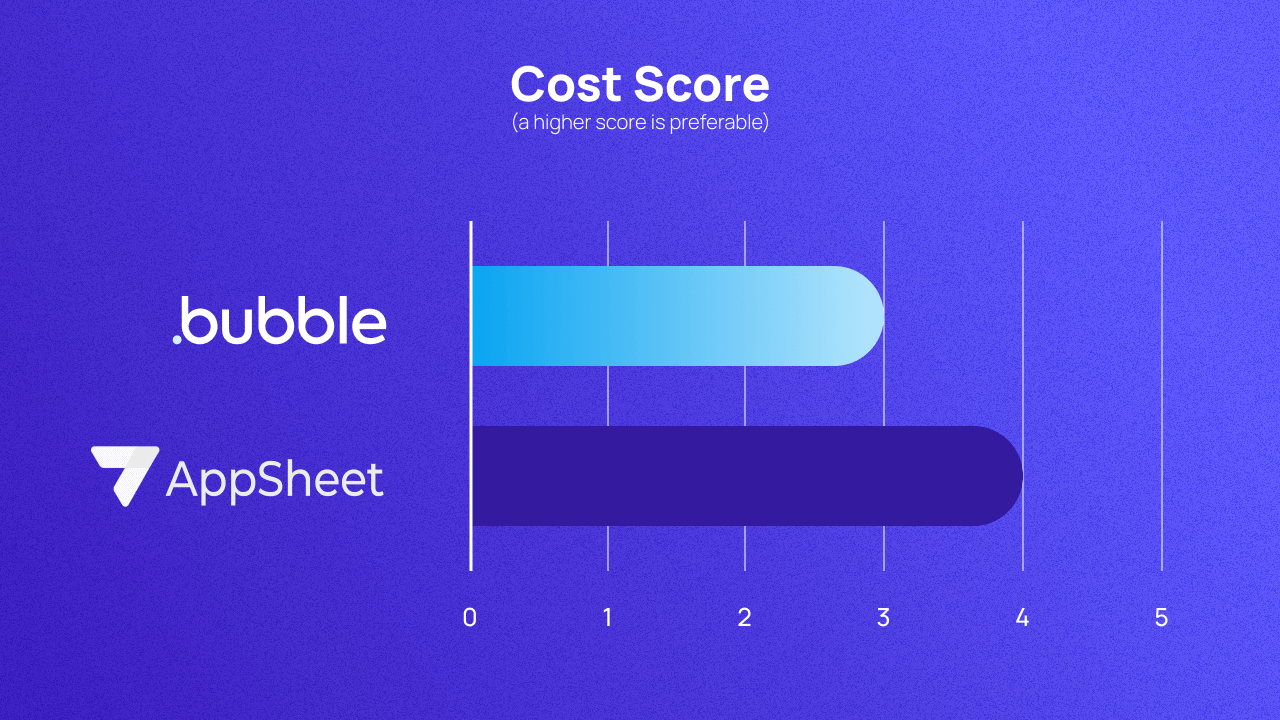
The cost grades we gave AppSheet and Bubble consider the cost of using the tool, with higher scores reflecting lower costs. While there are many factors that impact cost, we primarily took into account the pricing model and the platform’s price and how much free access the vendor allows.
Bottom line: AppSheet offers affordable pricing, especially for internal team usage. Bubble offers workload-based pricing, allowing users of all types — startups, enterprises, and SMBs — to scale their apps to large user bases.
| Score | Criteria |
|---|---|
| 1 | No free tier |
| 2 | Free tier, deployment on custom domain costs more than $50 per month |
| 3 | Free tier, deployment on custom domain costs less than $50 per month |
| 4 | Free tier, deployment on custom domain costs less than $10 per month |
| 5 | Free deployment on custom domain |
How AppSheet stacks up: AppSheet pricing starts at $5 per user per month for the basic plan, which includes the primary features, but not many security, governance, or team collaboration features. Keep in mind that AppSheet considers anyone who uses your app — whether they’re signed in or not — a “user” that you’ll need to pay for a license for.
This makes AppSheet a very affordable option for smaller teams with consistent user bases, but a very expensive option for larger teams or teams planning to scale their apps for external customers, clients, or users.
AppSheet’s cost score: 4/5
How Bubble compares: Bubble’s Free plan gives you access to the platform until you take your software live.
Once you launch, paid monthly plans vary based on the workload demand of your software, the capabilities you need, and the number of editors you have. Since Bubble is such a flexible and open-ended solution, we use a concept called “workload units” to account for usage instead of bandwidth, with various activities using a different number of these units.
This allows us to scale our servers and pricing with your software, rather than penalizing larger companies for having more team members if they’re not using a lot of resources. Paid plans start at $29.99 per month.
Bubble’s cost score: 3/5
AppSheet vs. Bubble on customizability
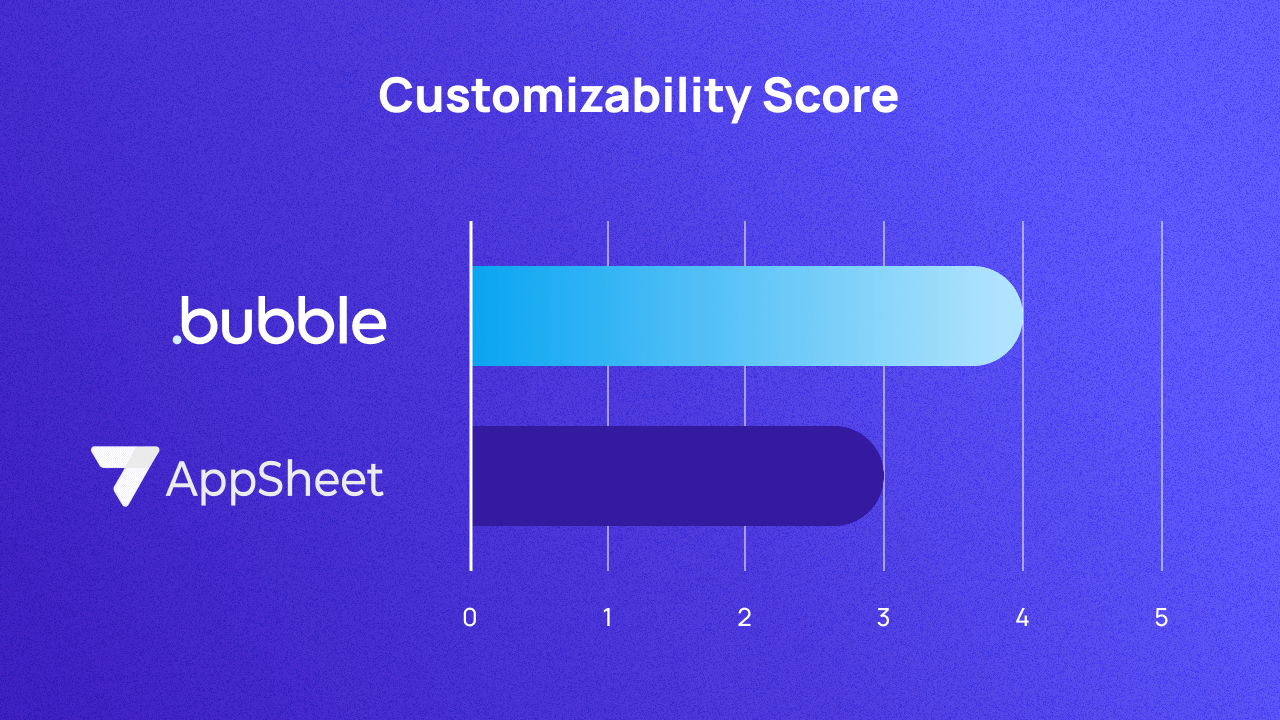
Customization is a core component of no-code builders. You want to have the flexibility and control to make your app look and work exactly the way you need it to — and ideally, you want that customization to be fairly simple.
Some apps offer full customization options and even bring in generative AI power to help you customize your app more easily. Others gate many customization choices behind custom code (which, honestly, somewhat defeats the purpose of a no-code platform). Others don’t offer many customization options at all.
In this comparison, our customizability scores are based on how flexible a platform is — both in terms of what you can build with it, and how easy it is to add new features throughout your software’s lifecycle. We also considered whether the platform makes customization easier with AI.
Bottom line: Bubble offers far more customization than AppSheet does. AppSheet's customization is limited to pre-set options and choices, while Bubble gives you a blank slate from which you can build anything you imagine.
| Score | Criteria |
|---|---|
| 1 | Minimal ability to customize frontend, minimal ability to add new functionality, high level of difficulty to build beyond templates |
| 2 | Customizable frontend, minimal ability to add new functionality, limited generative AI assistance |
| 3 | Customizable frontend, open to adding new functionality, robust frontend AI use cases |
| 4 | Everything from 3, plus AI-generated logic and data schema |
| 5 | Everything from 4, plus conversational editing that allows for entire AI-generated apps |
How AppSheet stacks up: AppSheet offers customization options for your design and your logic, but within pre-set guidelines. For example, you might be able to change the image shape from a circle to a square, or you might adjust the view of a data display (i.e., table, chart, Kanban, timeline). This fits within their “views,” UX, and branding customization options. For the most part, you’ll be working from pre-set templates and views, but then you can customize the look and feel from there.
You can also customize the logic of your app, adding new functionality through triggers and actions. Keep in mind that you can’t use GET API calls to third parties to add functionality, which limits your logic customizations.
AppSheet also offers some AI capabilities through Google’s Gemini, which allows users to use text-based prompts to get started on their apps.
AppSheet's customizability score: 3/5
How Bubble compares: Bubble’s customization capabilities are one of its biggest differentiators from most other no-code app builders, including AppSheet.
While AppSheet allows customization from a pre-set list of options, Bubble gives you a blank slate and lets you build anything you can imagine, exactly how you imagine it. That includes everything from design and layouts, branding, fonts, pages, workflows, actions, functionality, database organization, and more.
With Bubble, you’re never stuck in a box. Features like the AI app generator help you avoid the “blank-page” syndrome. Describe the app you want to build in your own words and Bubble AI will create an overview of key features. Add, remove, or edit key features as much as you want, and generate when you’re ready. In moments, you’ll have a beautiful, responsive, and functional application that’s ready for you to iterate on.
An added bonus: Although you should never have to use custom code to add capabilities or design customizations on Bubble, for those that want to, it’s always an option.
Bubble’s customizability score: 5/5
AppSheet vs. Bubble on compliance
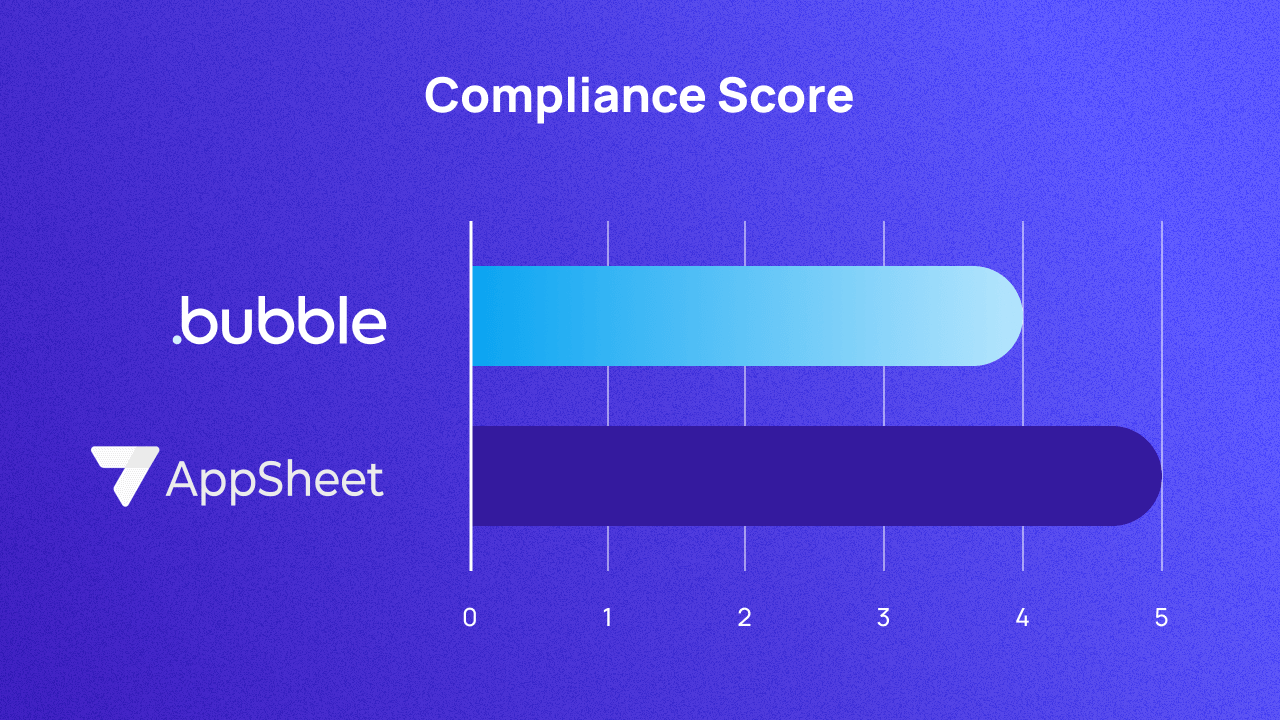
Security is a major component of finding the right no-code platform. After all, your app can only be as secure as the platform you build it on. Compliance standards help establish a baseline for security capabilities, and you can often increase your app’s security with additional security features as needed.
Our compliance scores are based on which standards a platform complies with by default and whether it offers a path to compliance with additional standards, with higher scores corresponding to more advanced standards.
Bottom line: Bubble and AppSheet both offer high levels of security. With AppSheet, some higher levels of compliance are only available on Enterprise plans, while with Bubble, higher compliance standards can be built-in by the developer on any plan level.
| Score | Criteria |
|---|---|
| 1 | No stated native compliance certifications |
| 2 | No native compliance certifications, but either 1) can be made compliant with plugins or 2) gives instructions for hosted apps to become compliant by themselves |
| 3 | SOC 2 Type I compliant |
| 4 | SOC 2 Type II compliant or ISO 27001 compliant |
| 5 | SOC 2 Type II compliant and HIPAA compliant |
How AppSheet stacks up: AppSheet offers SOC-2 Type II compliance, as well as compliance with other security standards like GDPR and HIPAA. This makes it a good choice for enterprise teams who need a higher level of security.
Just keep in mind that some security and governance features needed to make your app align with these standards, such as user roles, on-device encryption, and security filters, require Core or Enterprise Plus subscriptions to access.
AppSheet’s compliance score: 5/5
How Bubble compares: Bubble offers a high level of security and compliance that gives you a secure foundation to align your app and user data. Bubble has built-in compliance with SOC-2 Type II, which means it can pass long-term security audits. If you want to make your app compliant with other standards, like GDPR and HIPAA, you can check out our series of compliance articles that explain how to follow these standards when you build with Bubble.
Bubble’s compliance score: 4/5
AppSheet vs. Bubble on code ownership
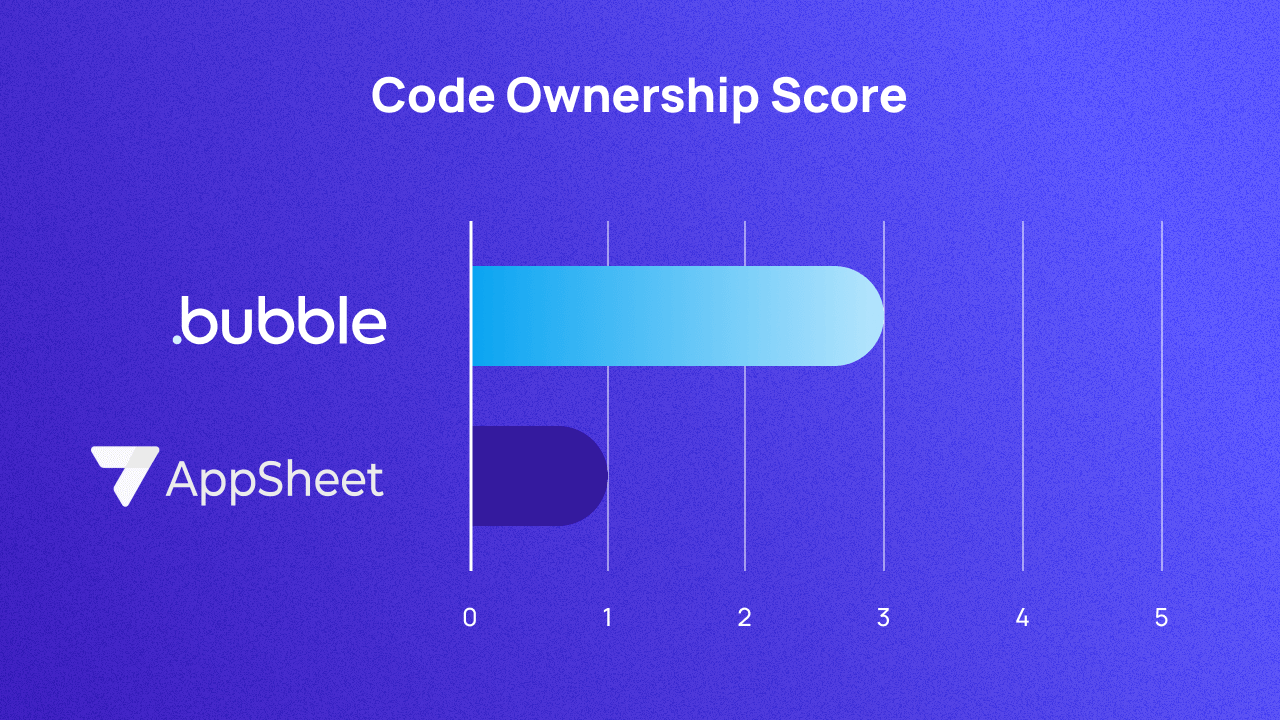
How important code ownership is depends on what you’re using the no-code platform for. If you’re creating a prototype or an MVP and don’t need to use your tool long-term, then code ownership might not be super important.
But if you’re looking for a long-term solution, it’s smart to go in knowing what you’ll be able to take with you in case you have to move to a new platform. What happens if your business outlives the vendor? What if you outgrow the vendor or need to expand your app beyond the capabilities of your current vendor? Our scoring criteria for the ownership category are based on how much freedom a platform gives you to export your work — specifically your code and your data.
Bottom line: AppSheet doesn’t allow you to export anything built in AppSheet. Bubble allows exports of databases, but can’t export your code.
| Score | Criteria |
|---|---|
| 1 | No exports supported |
| 2 | Allows partial data exports |
| 3 | Exports data, but not code |
| 4 | Exports data and code, but in limited languages and formats |
| 5 | Exports all data and code |
How AppSheet stacks up: AppSheet is unfortunately pretty straightforward in this category — you can’t export anything. Since AppSheet doesn’t host any data internally, it should be possible to move your data from wherever it is to a new platform, but any visual or logic parts will have to be re-built from scratch if you need to switch vendors.
AppSheet’s code ownership score: 1/5
How Bubble compares: Bubble lets you export your data easily, but you can’t export code. This is because Bubble’s proprietary source code enables your software’s functionality, so you can’t export your code without breaking it.
However, our promise to our users is that if your organization outlasts Bubble, we’ll release our source code under an open-source license. This makes Bubble a much safer choice for long-term visions and projects.
Bubble’s code ownership score: 3/5
AppSheet vs. Bubble on learning curve
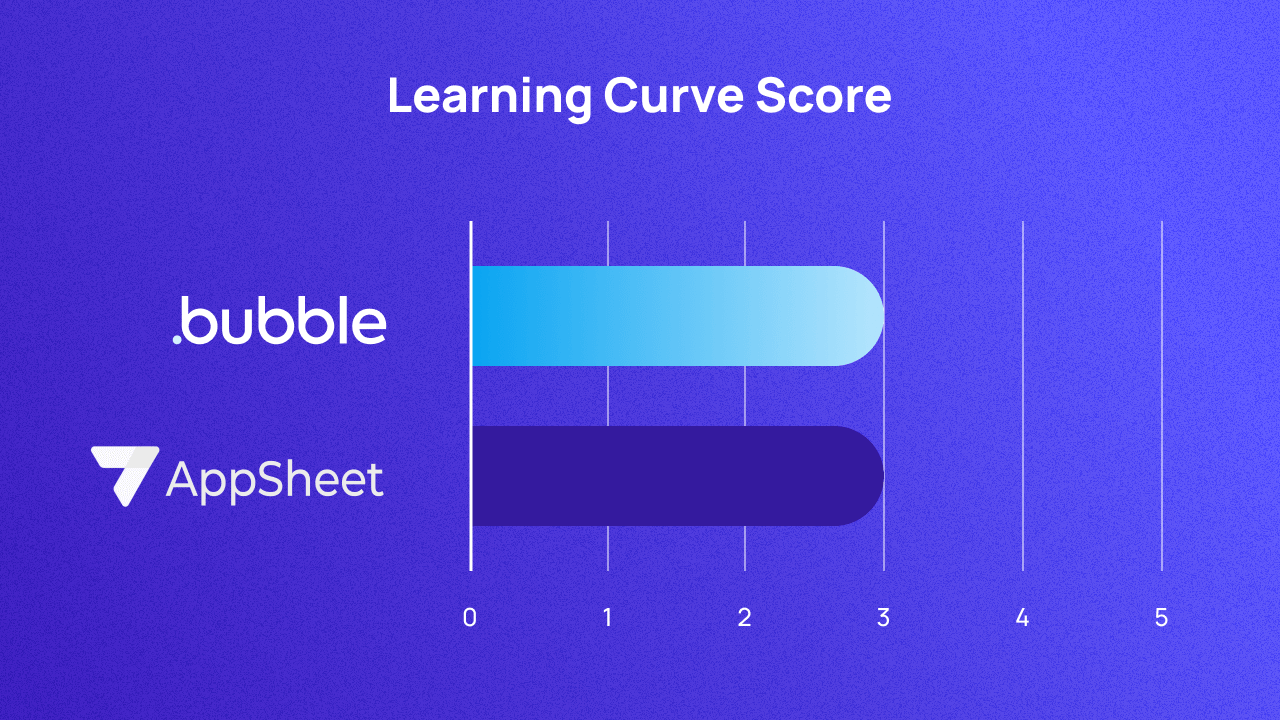
Compared to traditional code, no-code programming is much easier to learn. However, that doesn’t make it effortless. There will always be a learning curve, but it’s important to consider how steep of a curve you’re willing to take on.Each no-code platform is different and uses visual programming in different ways. Any platform will require you to take some time to understand how the platform works and how to make it do what you want. Some platforms require more technical backgrounds than others, while others are so simple you can be up and running in less than a day.
Our ease of use scoring criteria is based on how difficult a platform is to learn, and how fast you can start building.
Bottom line: AppSheet's step-by-step builder makes it easy to get started, but it requires more investment to build something custom. Bubble’s open-ended builder is super simple and intuitive to get started with, but also requires a bit more time to learn comprehensively. However, Bubble provides lots of different ways to get started and streamline your learning process.
| Score | Criteria |
|---|---|
| 1 | Extremely difficult to learn (comparable to learning code), demands significant technical knowledge, extensive time investment |
| 2 | Very difficult to learn, demands strong understanding of logic and some technical familiarity, extensive time investment |
| 3 | Moderately difficult to learn, demands moderate technical familiarity, moderate time investment (courses, tutorials, community support, etc.) |
| 4 | Somewhat easy to learn, demands minimal technical familiarity, allows you to start building on your first day |
| 5 | Extremely easy to learn, no technical familiarity needed, allows you to build something in your first hour |
How AppSheet stacks up: Due to AppSheet’s simple and templated builder, which takes you through the build process with step-by-step forms and instructions, getting started is pretty easy. However, there are limited API tools and UI tooling for more advanced features and capabilities, which means it’s difficult to build something more robust.
Most developers, however, will be able to build new tools and apps with AppSheet in a day or two, with some practice. Those without technical familiarity will probably need more time to understand the platform and create custom tools.
AppSheet’s learning curve score: 3/5
How Bubble compares: Bubble is incredibly easy to get started with, but takes some work to learn fully. This is mostly due to how open-ended Bubble’s editor and platform are. Since you can build anything, it may take some more time to understand how to use the platform best to suit your needs.
However, Bubble provides a wealth of resources and a variety of paths to learn. More importantly, Bubble also offers many ways to get past the blank page and get your app off the ground ASAP.
For example, starting from a template can help you quickly turn straightforward ideas into fully developed apps. Or, you can explain your idea to Bubble Assist. You can provide as much or as little detail as you want, and Bubble’s AI will understand your prompt and suggest the features, data types, and layout you may want to use, with guides to what adding each capability entails.
A technical background helps you get more from the platform, faster, but you don’t need experience to hit the ground running.
Bubble’s learning curve score: 3/5
AppSheet vs. Bubble on education and documentation resources
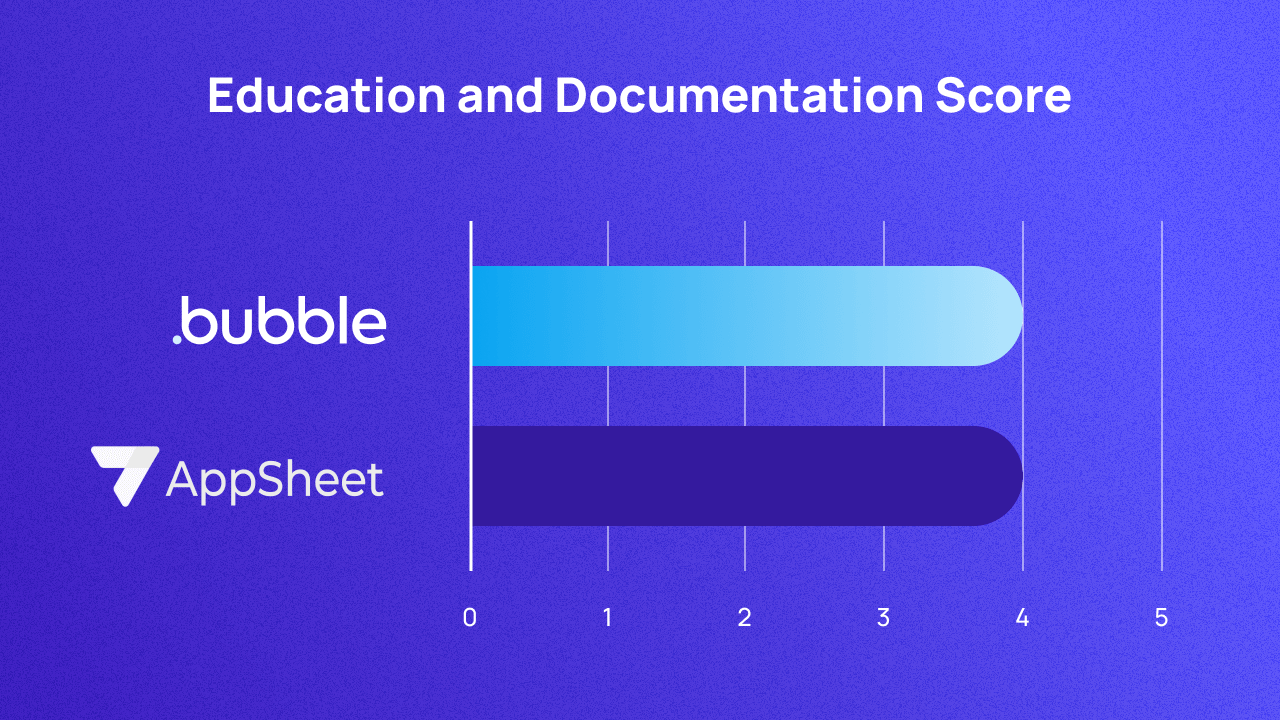
Even if you’re an experienced developer, you can’t expect to know the ins and outs of a platform right off the bat. So for developers and non-technical founders alike, good documentation, self-guided educational resources, and technical support are a must for good no-code platforms. This way, you always have what you need to learn something new, add a new feature to your app, or troubleshoot a challenge.
Bottom line: AppSheet offers thorough technical documentation for building and learning the basic elements and components of AppSheet, but Bubble offers much more varied resources for learning, including videos, tutorials, interactive lessons, courses, and more.
| Score | Criteria |
|---|---|
| 1 | Low-quality educational resources |
| 2 | Medium-quality resources |
| 3 | High-quality resources, low coverage |
| 4 | High-quality resources, medium coverage |
| 5 | High-quality resources, comprehensive coverage |
How AppSheet stacks up: AppSheet offers thorough and high-quality documentation via its Help Center articles, that cover just about everything you can do in AppSheet. Just a heads up, though: This documentation is pretty technical, text-heavy, and can be a bit hard to follow. If you already have some technical background, these articles will likely be easier for you to follow.
Some users report they have more success with the Community forum for user-friendly help and support.
AppSheet also offers some YouTube documentation for the most essential how-tos in AppSheet, and a few foundational courses to help you get started with the most important information.
AppSheet’s resources score: 4/5
How Bubble compares: Since there are so many ways to use the Bubble platform, we’ve made a ton of ways to learn the platform as well. We have a huge library of both high-level educational resources and technical documentation.
- Want to get started right away and have some technical background? Start building and turn to our online user manual or hundreds of YouTube videos and tutorials if you get stuck.
- Not as much technical background? Get started with our step-by-step tutorials, use our AI guide while building, or build alongside a video tutorial.
- Want to learn first, then build? Check out our courses and interactive lessons to be guided through the process first.
- Need to launch your app quickly and want dedicated support? Join a Bubble bootcamp to engage with dedicated coaches and a group of other learners to build and launch your Bubble app in a matter of weeks.
When you’re ready to really take a deep dive into building on Bubble, our developer certification program is an excellent way to learn the platform inside and out.
No matter what you’re looking to get out of the platform, we have resources to meet you where you are and take you where you want to go.
Bubble’s resources score: 4/5
AppSheet vs. Bubble on community
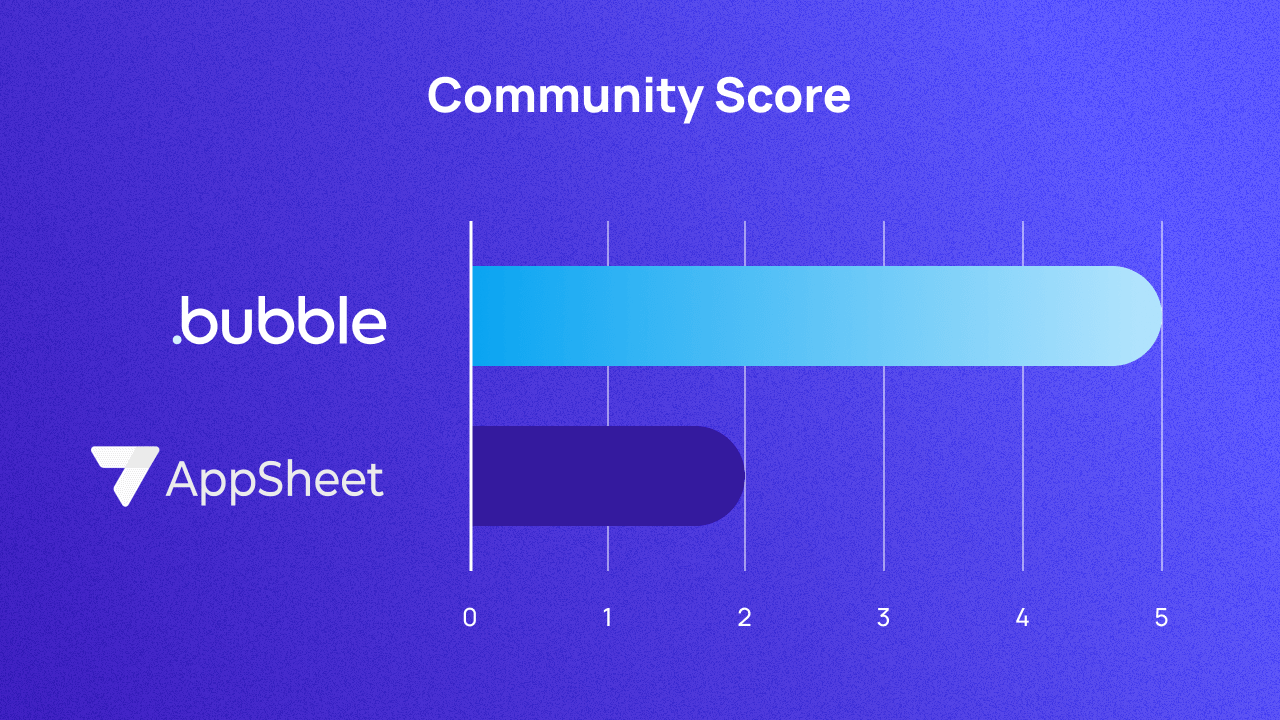
Community is an important — and often initially underrated — aspect of finding the right no-code platform for your projects. The larger and more active a platform’s community is, the more support you’ll have when you get stuck. Communities are also a key place for recommendations, tips, and feedback as you work on your projects.
It’s also worth asking how involved the vendor is in those communities. The more actively involved vendors are, the easier it is for them to be aware of users’ needs and sentiments — and the more access you have to the people who make decisions about the platform.
Our scores reflect how active a platform’s developer community is and the degree to which the platform vendor participates in the community.
Bottom line: AppSheet offers an online forum with some community engagement as well as a 24/7 support line. Bubble offers a highly-engaged developer community forum, dozens of community-led groups on other channels, events, and more.
| Score | Criteria |
|---|---|
| 1 | No community channels |
| 2 | Community channels exist, but participation is low |
| 3 | Active community, some company participation |
| 4 | Robust community, regular and valuable company participation |
| 5 | Everything in 4, plus in-person company events |
How AppSheet stacks up: AppSheet does offer a community forum with some engagement, but company participation is generally low. Many channels see about a dozen or fewer posts per week, but not all questions always get answered. You can see announcements and feature updates from the company in those channels, but otherwise, other developers mainly provide help and support.
AppSheet also offers 24/7 chat or email support for technical support.
AppSheet’s community score: 2/5
How Bubble compares: Bubble’s developer community is one of its greatest strengths. We know that having the right support around you can make all the difference on your app development journey, so we put a lot of time and energy into making sure you have the community you need!
Our main community outlet is our highly active forum. Posts here regularly see thousands of views and hundreds of comments, but Bubble users are also active on multiple subreddits, Discord groups, WhatsApp, Slack, Facebook, and more. If you have a question or need support, you’ll be able to get answers and help.
Bubble also hosts in-person and virtual events, which are a great way to learn more about Bubble, advance your skills, and connect with other builders and founders. For company announcements and updates, you can always follow us on X, watch the Bubble blog, and of course, attend our annual BubbleCon!
Bubble’s community score: 5/5
Bubble vs. AppSheet: Which one is right for you?
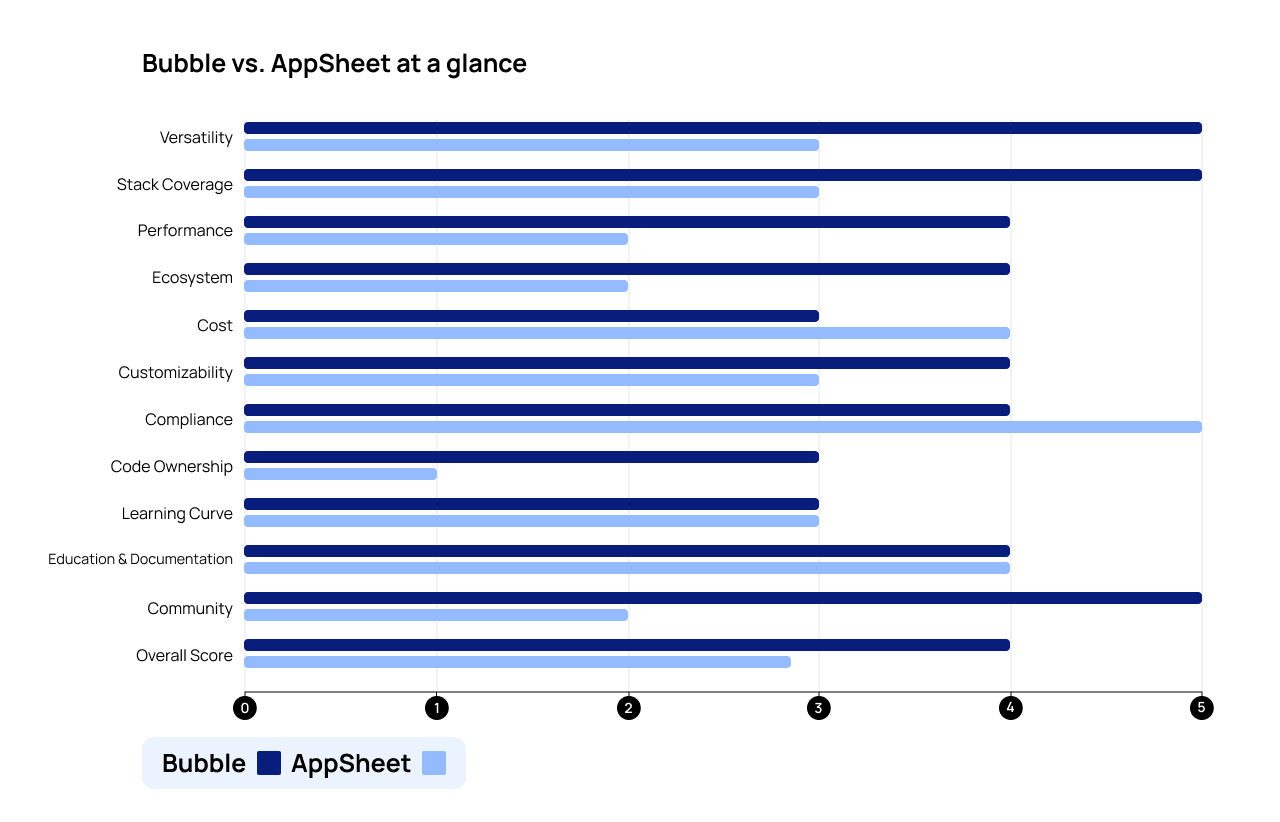
Bubble and AppSheet are both no-code tools that offer affordable, secure ways to create apps without extensive coding skills. However, that’s pretty much where the similarities end, as these two platforms are pretty different and serve different business needs.
AppSheet is a viable option for teams looking to build simple, internal tools to organize and control data or business processes within the Google Suite. For example, Appsheet can help you manage order and delivery tracking within a Google Sheet, or automate sales workflows within Gmail and Google Calendar by creating a simple appointment booking app interface.
However, despite being fairly easy to learn, AppSheet doesn’t offer much versatility, scalability, or customization, which means you’re mostly limited to the existing templates and functions within AppSheet. In addition, AppSheet doesn’t offer full-stack coverage or an extended ecosystem to expand your app’s capabilities or connect it with your entire tech stack.
It’s mostly a way to add a more user-friendly, visual interface to existing databases to make them easier to interact with. A limited use case, but for some teams, a convenient solution.
On the other hand, Bubble offers a full-stack, completely customizable solution that allows you to build custom, complex web and mobile apps for any use case or industry. Bubble brings the power of no-code and visual programming to give you flexibility, versatility, customization, and control over what you create and how it looks and performs.
Whether you want to build an internal tool, a marketplace, a social media network or community, a CRM, a SaaS product, or more, you can do it on Bubble.
Besides giving you a blank slate and tons of developing power, Bubble also offers the support you need to build what you want, even with minimal technical experience. With an engaged community, a robust ecosystem of third-party integrations and plugins, and all the educational and documentation resources you need to support your learning, Bubble makes it easy to build the design, data, and logic of your app, all in one place.
Want to see how Bubble compares to other platforms? Check out some of our other comparison pages:
Choose the no-code development platform that’s right for you
The no-code platform you choose completely shapes what your products and tools can actually do, the speed with which you can bring them to market, the ongoing impact development has on your budget, and the experience you’ll have for years to come.
The best way to decide which no-code platform is right for you? Try them yourself. You’ll see the difference, especially if you start with these comparisons in mind.
Build for as long as you want on the Free plan. Only upgrade when you're ready to launch.
Join Bubble






